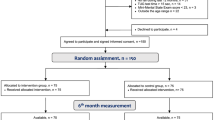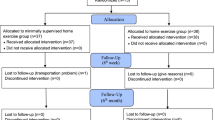Key summary points
This study evaluated the effects of Otago exercises on falls, balance, and physical performance in older adults with high falls risk living in a nursing home.
AbstractSection FindingsThe Otago exercise group showed a significantly greater reduction in number of falls at the end of the 3-month intervention compared to the walking group.
AbstractSection MessageThe Otago exercise program may have a role in the prevention of falls in older persons.
Abstract
Purpose
The aim of this study was to evaluate the effects of Otago exercises on falls, balance, and physical performance in old-aged adults with high fall risk living in a nursing home.
Methods
This randomized controlled trial included 72 individuals over 65 years of age residing in a single nursing home in Izmir, Turkey. The participants were randomized into the Otago exercise group and walking (control) group. The Otago group performed 45 min of Otago exercises 3 days/week for 12 weeks plus a walking program on 3 other days of the week. The control group did only the walking program (minimum of 30 min 3 days/week). Number of falls, Berg Balance Scale (BBS), 30-s Chair Stand Test (30 s-CST), and 6-min Walk Test (6MWT) were assessed before the intervention and at the end of the 3-month intervention. The primary outcome was number of falls.
Results
The groups were well matched in terms of age (74.6 ± 5.9 vs. 75.8 ± 4.5) and sex (p > 0.05). The Otago group showed a significantly greater reduction in number of falls at the end of the intervention (p < 0.05). Of the secondary outcomes, the Otago group had greater median increases in BBS score (p < 0.05) and 30 s-CST score (p < 0.05) post-intervention compared to the walking group. There was no significant difference between the groups in terms of post-intervention change in 6MWT distance (p > 0.05).
Conclusion
The Otago exercise program improved balance and physical performance and reduced falls in our sample and may be effective in falls prevention interventions for old-aged nursing home residents.

Similar content being viewed by others
References
Gamage N, Rathnayake N, Alwis G (2018) Knowledge and perception of falls among community dwelling elderly: a study from southern Sri Lanka. Curr Gerontol Geriatr Res. https://doi.org/10.1155/2018/7653469
Stack M (2017) Falls are unintentional: studying simulations is a waste of faking time. J Rehabil Assist Technol Eng 4:1–11. https://doi.org/10.1177/2055668317732945
Stevens JA, Lee R (2018) The potential to reduce falls and avert costs by clinically managing fall risk. Am J Prev Med 55(3):290–297. https://doi.org/10.1016/j.amepre.2018.04.035
Zhao YL, Bott M, He J, Kim H, Park SH, Dunton N (2019) Evidence on fall and injurious fall prevention interventions in acute care hospitals. J Nurs Adm 49(2):86–92. https://doi.org/10.1097/NNA.0000000000000715
Cuevas-Trisan R (2019) Balance problems and fall risks in the elderly. Clin Geriatr Med 35(2):173–183. https://doi.org/10.1016/j.cger.2019.01.008
Poscia A, Milovanovic S, La Milia DI et al (2018) Effectiveness of nutritional interventions addressed to elderly persons: umbrella systematic review with meta-analysis. Eur J Public Health 28(2):275–283. https://doi.org/10.1093/eurpub/ckx199
World Health Organization (2020). Global Report on Falls Prevention in Older Age. 2007. https://www.who.int/ageing/publications/Falls_prevention7March.pdf?ua=1. Accessed 13 Jun 2020
Preventing Falls: a guide to implementing effective community-based fall prevention programs. Division of Unintentional Injury Prevention National Center for Injury Prevention and Control Centers for Disease Control and Prevention. Atlanta, Georgia. 2015. https://www.cdc.gov/homeandrecreationalsafety/pdf/falls/FallPreventionGuide-2015-a.pdf. Accessed 13 Jun 2020
Sherrington C, Michaleff ZA, Fairhall N, Paul SS, Tiedemann A, Whitney J et al (2017) Exercise to prevent falls in older adults: an updated systematic review and meta-analysis. Br J Sports Med 51:1750–1758. https://doi.org/10.1136/bjsports-2016-096547
Moreno-Segura N, Igual-Camacho C, Ballester-Gil Y, Blasco-Igual MC, Blasco JM (2018) The effects of the pilates training method on balance and falls of older adults: a systematic review and meta-analysis of randomized controlled trials. J Aging Phys Act 26(2):327–344. https://doi.org/10.1123/japa.2017-0078
Arkkukangas M, Söderlund A, Eriksson S, Johansson AC (2019) Fall preventive exercise with or without behavior change support for community-dwelling older adults: a randomized controlled trial with short-term follow-up. J Geriatr Phys Ther 42(1):9–17. https://doi.org/10.1519/JPT.0000000000000129
Beato M, Dawson N, Svien L, Wharton T (2019) Examining the effects of an Otago-based home exercise program on falls and fall risks in an assisted living facility. J Geriatr Phys Ther 42(4):224–229. https://doi.org/10.1519/JPT.0000000000000190
Fthenos G (2020) The Otago exercise program: a home-based, individually tailored strength and balance retraining program. In: Volpe R (ed) Casebook of traumatic injury prevention. Springer, Cham. https://doi.org/https://doi.org/10.1007/978-3-030-27419-1_17
Liew LKM, Tan MP, Tan PJ, Mat S, Majid LA, Hill KD, Mazlan M (2019) The modified Otago exercises prevent grip strength deterioration among older fallers in the Malaysian falls assessment and intervention trial (MyFAIT). J Geriatr Phys Ther 42(3):123–129. https://doi.org/10.1519/JPT.0000000000000155
Stevens JA, Burns E (2020) CDC Compendium of Effective Fall Interventions: What Works for Community-Dwelling Older Adults, 3rd ed. Centers for Disease Control and Prevention, National Center for Injury Prevention and Control. Atlanta, Georgia; 2015. https://www.cdc.gov/homeandrecreationalsafety/pdf/falls/CDC_Falls_Compendium-2015-a.pdf Accessed 13 Jun 2020
Shubert TE, Goto LS, Smith ML, Jiang L, Rudman H, Ory MG (2017) The Otago exercise program: innovative delivery models to maximize sustained outcomes for high risk. Homebound Older Adults Front Public Health 5:54. https://doi.org/10.3389/fpubh.2017.00054
Son NK, Ryu YU, Jeong HW, Jang YH, Kim HD (2016) Comparison of 2 different exercise approaches: Tai Chi versus Otago, in community-dwelling older women. J Geriatr Phys Ther 39(2):51–57. https://doi.org/10.1519/JPT.0000000000000042
Kyrdalen IL, Moen K, Røysland AS, Helbostad JL (2014) The Otago exercise program performed as group training versus home training in fall-prone older people: a randomized controlled trial. Physiother Res Int 19(2):108–116. https://doi.org/10.1002/pri.1571
Ministry of Health of the Republic of Turkey. Fall risk Scale. Itaki Fall Risk Scale. https://kalite.saglik.gov.tr/EN,48970/itaki-fall-risk-scale.html. Accessed 13 Jun 2020
Sönmez G, Keske M, Tombul S, Karadağ M, Demirtas A (2019) Evaluation of the risk of falls in the patients hospitalized in a urology inpatient clinic. Bull Urooncol 18:12–16. https://doi.org/10.4274/uob.galenos.2019.1240
Wallace M, Shelke M (2007) Katz index of independence in activities of daily living (ADL). Nurs Clin N Am 39(3):473–493
American Psychiatric Association (2013) Diagnostic and statistical manual of mental disorders, 5th edn. American Psychiatric Association, Arlington
Ganz DA, Higashi T, Rubenstein LZ (2005) Monitoring falls in cohort studies of community-dwelling older people: effect of the recall interval. J Am Geriatr Soc 53(12):2190–2194. https://doi.org/10.1111/j.1532-5415.2005.00509.x
Lima CA, Ricci NA, Nogueira EC, Perracini MR (2018) The Berg Balance Scale as a clinical screening tool to predict fall risk in older adults: a systematic review. Physiotherapy 104(4):383–394. https://doi.org/10.1016/j.physio.2018.02.002
Chou CY, Chien CW, Hsueh IP, Sheu CF, Wang CH, Hsieh CL (2006) Develo** a short form of the Berg Balance Scale for people with stroke. Phys Ther 86:195–204
Şahin F, Yilmaz F, Ozmaden A, Kotevolu N, Sahin T, Kuran B (2008) Reliability and validity of the Turkish version of the Berg Balance Scale. J Geriatr Phys Ther 31(1):32–37. https://doi.org/10.1519/00139143-200831010-00006
Millor N, Lecumberri P, Gómez M, Martínez-Ramírez A, Izquierdo M (2013) An evaluation of the 30-s chair stand test in older adults: frailty detection based on kinematic parameters from a single inertial unit. J Neuroeng Rehabil 10:86. https://doi.org/10.1186/1743-0003-10-86
Jones CJ, Rikli RE, Beam WC (1999) A 30-s chair-stand test as a measure of lower body strength in community-residing older adults. Res Q Exerc Sport 70(2):113–119
Kargarfard M, Shariat A, Ingle L, Cleland JA, Kargarfard M (2018) Randomized controlled trial to examine the impact of aquatic exercise training on functional capacity, balance, and perceptions of fatigue in female patients with multiple sclerosis. Arch Phys Med Rehabil 99(2):234–241. https://doi.org/10.1016/j.apmr.2017.06.015
America Thoracic Society (2002) ATS statement: guidelines for the six-minute walk test. Am J Respir Crit Care Med 166(1):111–117
Baird JF, Cederberg KLJ, Sikes EM, Silveira SL, Jeng B, Sasaki JE, Sandroff BM, Motl RW (2019) Physical activity and walking performance across the lifespan among adults with multiple sclerosis. Mult Scler Relat Disord 35:36–41. https://doi.org/10.1016/j.msard.2019.07.003
Benavent-Caballer V, Rosado-Calatayud P, Segura-Ortí E, Amer-Cuenca JJ, Lisón JF (2016) The effectiveness of a video-supported group-based Otago exercise programme on physical performance in community-dwelling older adults: a preliminary study. Physiotherapy 102(3):280–286. https://doi.org/10.1016/j.physio.2015.08.002
Yoo HN, Chung E, Lee BH (2013) The effects of augmented reality-based Otago exercise on balance, gait, and falls efficacy of elderly women. J Phys Ther Sci 25(7):797–801. https://doi.org/10.1589/jpts.25.797
Ries JD, Hutson J, Maralit LA, Brown MB (2015) Group balance training specifically designed for individuals with alzheimer disease: impact on berg balance scale, timed up and go, gait speed, and mini-mental status examination. J Geriatr Phys Ther 38(4):183–193. https://doi.org/10.1519/JPT.0000000000000030
Ferraro FV, Gavin JP, Wainwright TW, McConnell AK (2020) Comparison of balance changes after inspiratory muscle or Otago exercise training. PLoS ONE 15(1):e0227379. https://doi.org/10.1371/journal.pone.0227379
Shubert TE, Smith ML, Goto L, Jiang L, Ory MG (2017) Otago exercise program in the United States: comparison of 2 implementation models. Phys Ther 97(2):187–197. https://doi.org/10.2522/ptj.20160236
Dadgari A, Aizan Hamid T, Hakim MN, Chaman R, Mousavi SA, Poh Hin L et al (2016) Randomized control trials on Otago Exercise Program (OEP) to reduce falls among elderly community dwellers in Shahroud, Iran. Iran Red Crescent Med J 18(5):e26340. https://doi.org/10.5812/ircmj.26340
Shubert TE, Smith ML, Jiang L, Ory MG (2018) Disseminating the Otago exercise program in the United States: perceived and actual physical performance improvements from participants. J Appl Gerontol 37(1):79–98. https://doi.org/10.1177/0733464816675422
Renfro M, Bainbridge DB, Smith ML (2016) Validation of evidence-based fall prevention programs for adults with intellectual and/or developmental disorders: a modified Otago Exercise Program. Front Public Health 4:261. https://doi.org/10.3389/fpubh.2016.00261
Voukelatos A, Merom D, Sherrington C, Rissel C, Cumming RG, Lord SR (2015) The impact of a home-based walking programme on falls in older people: the Easy Steps randomised controlled trial. Age Ageing 44(3):377–383
Liu-Ambrose T, Davis JC, Best JR, Dian L, Madden K, Cook W et al (2019) Effect of a home-based exercise program on subsequent falls among community-dwelling high-risk older adults after a fall: a randomized clinical trial. JAMA 321(21):2092–2100. https://doi.org/10.1001/jama.2019.5795
Burton E, Lewin G, O'Connell H, Hill KD (2018) Falls prevention in community care: 10 years on. Clin Interv Aging 13:261–269. https://doi.org/10.2147/CIA.S153687
Mohammed R, Nour-Eldein H, Waheed El Din Abdel Halim A, Ahmed AA (2018) Effect of a fall prevention program for elderly persons attending a rural family medicine center. Egypt J Public Health. https://doi.org/10.1007/s10389-018-0959-8
Funding
N/A.
Author information
Authors and Affiliations
Corresponding author
Ethics declarations
Conflict of interest
The authors declare that they have no conflict of interest.
Ethical approval
The study protocol was approved by the ethics committee of Ege University Faculty of Medicine (Number 70198063-050.06.04). All procedures performed in studies involving human participants were in accordance with the 1964 Declaration of Helsinki and its later amendments or comparable ethical standards.
Informed consent
All of the patients were informed of the study protocols in detail and provided their informed written consent.
Additional information
Publisher's Note
Springer Nature remains neutral with regard to jurisdictional claims in published maps and institutional affiliations.
Rights and permissions
About this article
Cite this article
Jahanpeyma, P., Kayhan Koçak, F., Yıldırım, Y. et al. Effects of the Otago exercise program on falls, balance, and physical performance in older nursing home residents with high fall risk: a randomized controlled trial. Eur Geriatr Med 12, 107–115 (2021). https://doi.org/10.1007/s41999-020-00403-1
Received:
Accepted:
Published:
Issue Date:
DOI: https://doi.org/10.1007/s41999-020-00403-1




